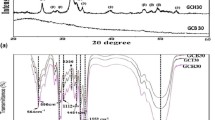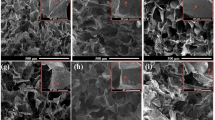Abstract
Nowadays repairing and regenerating of lost or damaged tissue still remain an important challenge in clinical techniques. Due to the variety of available bone grafts, different types of biodegradable materials are being utilized as a scaffold implant. The basic structure of the bone is an excellent natural composite which contains varieties of polymers and ceramics; therefore, it is important to manufacture a bone scaffold featuring sufficient mechanical strength, a good degree of biocompatibility, biodegradation and an increased rate of formation of new tissue. Bioactive glass has an appealing characteristic which can be utilized for repairing purposes as well as to cause a rapid response from the bone graft. In this study, a composite scaffold based on polymer matrix (gelatin-chitosan) and bioactive glass 58s was synthesized in the laboratory. Five samples of polymer scaffold with different proportions of bioactive glass were designed and investigated. The scaffolds were dried with freeze dryer, and a spongy structure was generated. The composite survey was carried out through FTIR technique to examine the crystallization of the structure, XRD to examine the morphology of the porosities, and SEM to examine the size of porosities and formation of apatite. This study reveals that the size of porosities is about 170–320 μm, which is suitable for angiogenesis and cell growth in the bone. The combination of enhanced properties and the formation of apatite on the surface of the scaffolds make them an ideal option as a bone substitute.
Similar content being viewed by others
References
Alaribe FN, Manoto SL, Motaung SCKM (2016) Scaffolds from biomaterials: advantages and limitations in bone and tissue engineering. Biologia (Bratisl) 71:353–366. https://doi.org/10.1515/biolog-2016-0056
Rong D, Chen P, Yang Y et al (2016) Fabrication of gelatin/PCL electrospun fiber mat with bone powder and the study of its biocompatibility. J Funct Biomater. https://doi.org/10.3390/jfb7010006
Dorea HC, McLaughlin RM, Cantwell HD et al (2005) Evaluation of healing in feline femoral defects filled with cancellous autograft, cancellous allograft or Bioglass. VCOT Arch 18:157–168
Boal D, Boal DH (2012) Mechanics of the cell. Cambridge University Press, Cambridge
Lee S-C, Chen J-F, Wu C-T, Lee S-T (2009) In situ local autograft for instrumented lower lumbar or lumbosacral posterolateral fusion. J Clin Neurosci 16:37–43. https://doi.org/10.1016/j.jocn.2008.02.009
Damien CJ, Parsons JR (1991) Bone graft and bone graft substitutes: a review of current technology and applications. J Appl Biomater 2:187–208. https://doi.org/10.1002/jab.770020307
Killion JA, Kehoe S, Geever LM et al (2013) Hydrogel/bioactive glass composites for bone regeneration applications: synthesis and characterisation. Mater Sci Eng C 33:4203–4212. https://doi.org/10.1016/j.msec.2013.06.013
Dimitriou R, Jones E, McGonagle D, Giannoudis PV (2011) Bone regeneration: current concepts and future directions. BMC Med 9:66. https://doi.org/10.1186/1741-7015-9-66
Park JB, Bronzino JD (2002) Biomaterials: principles and applications. CRC Press, Boca Raton
Enhancing bone healing and regeneration: present and future perspectives in veterinary orthopaedics. In: PubMed J. https://ncbi.nlm.nih.gov/labs/articles/20422117/. Accessed 16 Jun 2017
Schieker M, Seitz H, Drosse I, et al (2006) Biomaterials as scaffold for bone tissue engineering. Eur J Trauma 32:114–124. https://doi.org/10.1007/s00068-006-6047-8
Yannas IV (2005) Regenerative medicine II: clinical and preclinical applications. Springer Science & Business Media
Habraken WJEM, Wolke JGC, Jansen JA (2007) Ceramic composites as matrices and scaffolds for drug delivery in tissue engineering. Adv Drug Deliv Rev 59:234–248. https://doi.org/10.1016/j.addr.2007.03.011
Prabaharan M, Sivashankari PR (2016) Prospects of bioactive chitosan-based scaffolds in tissue engineering and regenerative medicine. Polym Compos Mater. https://doi.org/10.1007/978-81-322-2511-9_2
Olszta MJ, Cheng X, Jee SS et al (2007) Bone structure and formation: a new perspective. Mater Sci Eng R Rep 58:77–116. https://doi.org/10.1016/j.mser.2007.05.001
Linhart W, Peters F, Lehmann W et al (2001) Biologically and chemically optimized composites of carbonated apatite and polyglycolide as bone substitution materials. J Biomed Mater Res 54:162–171. https://doi.org/10.1002/1097-4636(200102)54:2<162::AID-JBM2>3.0.CO;2-3
Durucan C, Brown PW (2000) Low temperature formation of calcium-deficient hydroxyapatite-PLA/PLGA composites. J Biomed Mater Res 51:717–725. https://doi.org/10.1002/1097-4636(20000915)51:4<717::AID-JBM21>3.0.CO;2-Q
Hench LL, Splinter RJ, Allen WC, Greenlee TK (1971) Bonding mechanisms at the interface of ceramic prosthetic materials. J Biomed Mater Res 5:117–141. https://doi.org/10.1002/jbm.820050611
Day RM, Boccaccini AR, Shurey S et al (2004) Assessment of polyglycolic acid mesh and bioactive glass for soft-tissue engineering scaffolds. Biomaterials 25:5857–5866. https://doi.org/10.1016/j.biomaterials.2004.01.043
Verrier S, Blaker JJ, Maquet V et al (2004) PDLLA/Bioglass®;composites for soft-tissue and hard-tissue engineering: an in vitro cell biology assessment. Biomaterials 25:3013–3021. https://doi.org/10.1016/j.biomaterials.2003.09.081
Olmo N, Martın AI, Salinas AJ et al (2003) Bioactive sol–gel glasses with and without a hydroxycarbonate apatite layer as substrates for osteoblast cell adhesion and proliferation. Biomaterials 24:3383–3393. https://doi.org/10.1016/S0142-9612(03)00200-X
Muzzarelli R, Tarsi R, Filippini O et al (1990) Antimicrobial properties of N-carboxybutyl chitosan. Antimicrob Agents Chemother 34:2019–2023. https://doi.org/10.1128/AAC.34.10.2019
Jayakumar R, Prabaharan M, Reis R L, Mano J F (2005) Graft copolymerized chitosan—present status and applications. Carbohydr Polym 62:142–158. https://doi.org/10.1016/j.carbpol.2005.07.017
Muzzarelli R, Baldassarre V, Conti F et al (1988) Biological activity of chitosan: ultrastructural study. Biomaterials 9:247–252. https://doi.org/10.1016/0142-9612(88)90092-0
Jiankang H, Dichen L, Yaxiong L et al (2009) Preparation of chitosan–gelatin hybrid scaffolds with well-organized microstructures for hepatic tissue engineering. Acta Biomater 5:453–461. https://doi.org/10.1016/j.actbio.2008.07.002
Taboas JM, Maddox RD, Krebsbach PH, Hollister SJ (2003) Indirect solid free form fabrication of local and global porous, biomimetic and composite 3D polymer-ceramic scaffolds. Biomaterials 24:181–194. https://doi.org/10.1016/S0142-9612(02)00276-4
Kokubo T, Takadama H (2006) How useful is SBF in predicting in vivo bone bioactivity? Biomaterials 27:2907–2915. https://doi.org/10.1016/j.biomaterials.2006.01.017
Peter M, Binulal NS, Nair SV et al (2010) Novel biodegradable chitosan–gelatin/nano-bioactive glass ceramic composite scaffolds for alveolar bone tissue engineering. Chem Eng J 158:353–361. https://doi.org/10.1016/j.cej.2010.02.003
Isikli C, Hasirci V, Hasirci N (2012) Development of porous chitosan–gelatin/hydroxyapatite composite scaffolds for hard tissue-engineering applications. J Tissue Eng Regen Med 6:135–143. https://doi.org/10.1002/term.406
Yazdanpanah A, Kamalian R, Moztarzadeh F et al (2012) Enhancement of fracture toughness in bioactive glass-based nanocomposites with nanocrystalline forsterite as advanced biomaterials for bone tissue engineering applications. Ceram Int 38:5007–5014. https://doi.org/10.1016/j.ceramint.2012.02.097
Thein-Han WW, Saikhun J, Pholpramoo C et al (2009) Chitosan–gelatin scaffolds for tissue engineering: physico-chemical properties and biological response of buffalo embryonic stem cells and transfectant of GFP–buffalo embryonic stem cells. Acta Biomater 5:3453–3466. https://doi.org/10.1016/j.actbio.2009.05.012
Cholas R, Kunjalukkal Padmanabhan S, Gervaso F et al (2016) Scaffolds for bone regeneration made of hydroxyapatite microspheres in a collagen matrix. Mater Sci Eng C 63:499–505. https://doi.org/10.1016/j.msec.2016.03.022
Author information
Authors and Affiliations
Corresponding author
Rights and permissions
About this article
Cite this article
Ahmadi, Z., Moztarzadeh, F. Synthesizing and Characterizing of Gelatin-Chitosan-Bioactive Glass (58s) Scaffolds for Bone Tissue Engineering. Silicon 10, 1393–1402 (2018). https://doi.org/10.1007/s12633-017-9616-z
Received:
Accepted:
Published:
Issue Date:
DOI: https://doi.org/10.1007/s12633-017-9616-z




